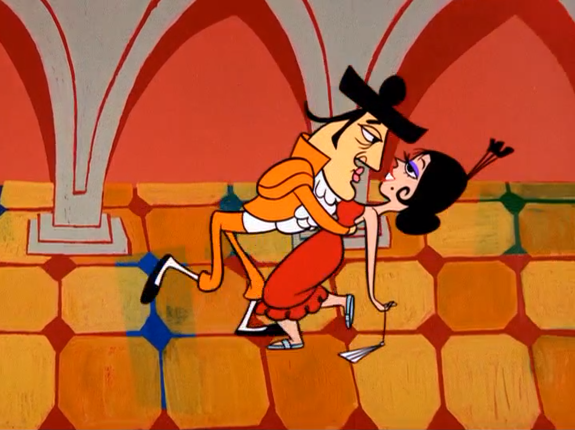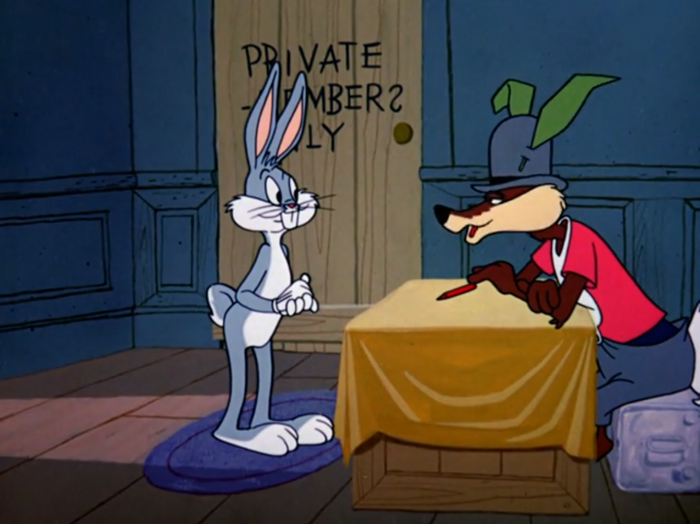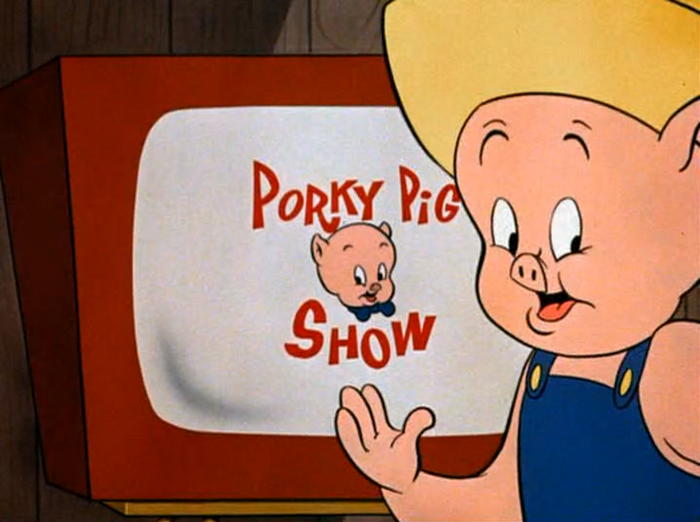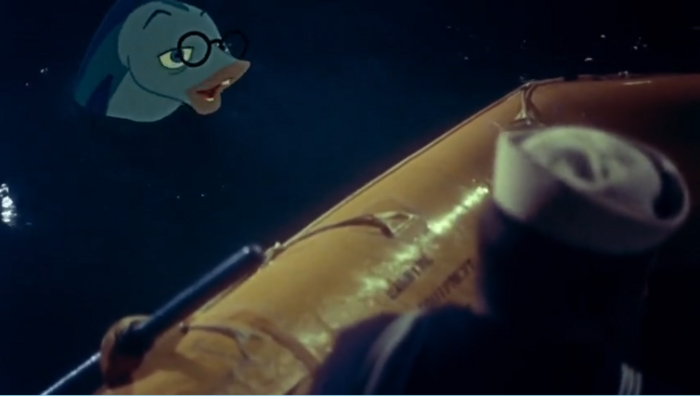1964: Friz, the producer
A year of big changes for the WB cartoons... in more ways than one!
Dumb Patrol
Directed by Gerry Chiniquy
Running out of titles? Bosko had already appeared in a cartoon with the same name back in 1931 (not that many would have remembered it anyway). Bugs knocks out a French soldier intending to take on Baron Sam von Schpamm since he has a wife and kids to look after. The rabbit therefore fights the baron in the air, constantly outwitting him. Fairly ordinary Bugs and Sam effort, except with planes and a couple of little new gags. Another new name in the director's chair – Chiniquy had been an animator on Freleng's cartoons since the early 40s. A solid though not spectacular debut for him. This was the last short to feature Yosemite Sam.
7.5
A Message to Gracias
Directed by Robert McKimson
After all his messengers have failed, El Supremo gets Speedy Gonzales to sneak a letter past Sylvester to General Gracias. Despite having many vehicles at his disposal, Sylvester is no match for the mouse's speed and wits. Kind of Road Runner-esque with the gags... and with one of the best endings in the Speedy Gonzales cartoons! We certainly see a new side to the fastest mouse in all Mexico here!
9
Bartholomew versus the Wheel
Directed by Robert McKimson
A boy narrates the story of his dog Bartholomew. After getting his tail run over by a scooter, Bartholomew starts chasing all kinds of wheels, which eventually leads him far away. A very unusual cartoon for WB – in addition to being narrated by a child, even the art style resembles a child's drawings. This and the strange story give it a special charm, making for a rather unique short. Not one of my absolute favorites, but something I'm glad the WB crew made, as this was one of the very last times they would experiment like this.
8.5
Freudy Cat
Directed by Robert McKimson
Sylvester Jr. takes his father to see psychiatrist Dr. Freud E. Katt, as he's a nervous wreck after seeing Hippety Hopper once again. The cats recount how the whole giant mouse problem started. Another cheater cartoon, as the stories of how Sylvester met the kangaroo are taken from a couple of earlier shorts and constitute a large part of the short. Rather similar to the earlier Sylvester cheater "Tweet Dreams", which also featured him nervously telling a doctor about his previous experiences with a character he was chasing. Again, the new sequences are reasonably fun, but there's too much reliance on old material. The doctor isn't the most memorable character, but his distinctly German accent and vocabulary still stands out. The last appearance of Hippety Hopper and Junior, who I feel both deserved a better sendoff.
7
Dr. Devil and Mr. Hare
Directed by Robert McKimson
Taz once again shows up, trying to eat Bugs, but the rabbit pretends to be a doctor and a maternity nurse among others to outwit him. While not as great as some of the earlier Taz cartoons, I found this an enjoyable one with the two characters' portrayals and funny gags with the recurring doctor theme. The most memorable thing about this might be that Bugs is shown as less infallible than usual! A good effort for the time. This was the last of only five cartoons to feature Taz, who would appear much more in the later revivals.
8.5
Nuts and Volts
Directed by Friz Freleng
Trying to catch Speedy is too tiring for Sylvester, so he decides to get a robot to do the work. But even this doesn't quite go the way he expected... Nothing really new, but an entertaining watch with solid portrayals of the characters and some fun gags.
8.5
The Iceman Ducketh
Directed by Phil Monroe
Co-director: Maurice Noble
When Daffy finds out the fur trader is paying well, he decides to go hunting. Winter suddenly comes, and Daffy struggles with the snow and ice as well as some bears while trying to shoot Bugs. One of the less popular Bugs and Daffy cartoons – I think there are some good gags here (Bugs' "invisible shield" being my favorite), but the director's lack of experience shows here more than it did on Monroe's debut last year. Some scenes are rather predictable – I can't help but feel someone like Chuck Jones could have worked wonders with better timing. And how does Bugs know Daffy is after him before they even meet in the cartoon? A decent but flawed entry, most likely owing to its troubled production (Jones was supposed to direct this before his firing). Monroe's last directorial work on the Looney Tunes and Merrie Melodies.
7.5
War and Pieces
Directed by Chuck Jones
Co-director: Maurice Noble
Wile E. Coyote's (Caninus nervous rex) attempts to catch the Road Runner (Burn-em upus asphaltus) with invisible paint, a gun disguised as a peepshow and other contraptions fail. Some of the gags here are rather ordinary by Road Runner standards, but there are a couple of things that really stand out! The "Secrets of a Harem" scene is the most daring one in this series, and the ending is slightly controversial by today's standards but quite clever at the same time. The last classic era short consisting of new content directed by Jones, who had been fired for moonlighting on UPA's "Gay Purr-ee". This brought to an end his three-decade run of WB cartoons, having started as an animator and then worked as a director since 1938. He moved to Sib Tower 12 Productions to direct and produce new Tom and Jerry cartoons for MGM, but he would eventually return to WB for some of the later Looney Tunes revivals. Also Noble's last co-direction, as he made the same move as Jones. The Road Runner cartoons would continue under different directors, though some aspects of the Jones cartoons (such as the Latin names) wouldn't carry over.
9.5
Hawaiian Aye Aye
Directed by Gerry Chiniquy
Tweety and Granny are on vacation in Honolulu. While Granny's away, a hungry Sylvester hears Tweety singing on another island, but his attempts to catch the bird get thwarted by a dog-like shark named Sharkey. This enjoyable short was the last cartoon of its kind in more than one way. Most significantly, Tweety made his last appearance here – despite his cute portrayal, most of the short focuses on the amusing antics of Sylvester and Sharkey, the latter being quite sly and adding some novelty to the formula. Chiniquy only directed two WB shorts, of which this was the latter and definitely the stronger. This was also the final original Merrie Melodies cartoon to use the long-running theme song "Merrily We Roll Along", which had been used for the series since 1936.
8.5
False Hare
Directed by Robert McKimson
The Big Bad Wolf and his nephew come up with a plan to catch Bugs for dinner – they disguise themselves as rabbits interested in joining Club del Conejo, the new club for rabbits. Bugs immediately sees through their plans but decides to play along anyway. Things end quite badly for Big Bad each time. The last Bugs Bunny cartoon released in the classic era – as there were already enough Bugs cartoons for both TV airings and theatrical reissues, the decision was made to focus on other popular characters. I think Bugs got quite a nice sendoff, with him being portrayed as the lovable trickster he is. Also a surprising comeback from the wolves that appeared in 1958's "Now, Hare This". They're again characterized well, with Big Bad's forced acting and eternal failures, as well as his nephew's adorable enthusiasm. The ending is also a funny one, including a surprise cameo! Being the original studio's last short with established characters, it was also the last appearance of the iconic rings in the opening and ending that had lasted 28 years, as well as the last to feature the phrase "That's all Folks!" in its end titles, which had been used since the start. The times sure are changing...
9

Señorella and the Glass Huarache
Directed by Hawley Pratt
In a restaurant, a Mexican man tells his friend the story of Señorella – a more modern, Mexican-themed version of Cinderella. She attends a party held for José, the bullfighting son of pig ranch owner Don Miguel, making an impression. The second and last time Hawley Pratt directed a WB cartoon on his own, 18 years after "Hollywood Daffy", and also the last released short to have been produced by the original Warner Bros. cartoon studio. With fairytale parodies having been a recurring theme over the run of the series, it was a fitting one to close this chapter. With the stylized animation, some quirkiness and rather simple gags, it's an appealing one. This also shows that the WB crew retained their creativity to the very end!
9
At this point, Warner Bros. Cartoons was shut down, ending a run of more than three decades. But it was by no means the end of the Looney Tunes and Merrie Melodies series. A new studio called DePatie-Freleng Enterprises was founded by Friz Freleng and the WB studio's last executive David H. DePatie, with many former Looney Tunes artists working for them. So it made perfect sense that DePatie-Freleng got the contract to make new cartoons for WB. The studio would also do other work for WB, such as the opening title animation for the movie "Sex and the Single Girl", but they were most famous for producing cartoon shorts for United Artists with characters such as the Pink Panther.
The new Looney Tunes and Merrie Melodies shorts were restricted to using a few of the most popular characters of the studio: Daffy Duck, Speedy Gonzales, Wile E. Coyote and the Road Runner, with a couple of other familiar faces making occasional appearances. No more one-shots would be made. The new cartoons used a slightly altered version of the abstract opening and closing titles created for "Now Hear This" in 1963 (which had also been used for the one-shots "Bartholomew versus the Wheel" and "Señorella and the Glass Huarache"). Both the Looney Tunes and the Merrie Melodies now started using the former's theme song "The Merry-Go-Round Broke Down", getting rid of essentially the last difference there was between the two series.

Pancho's Hideaway
Directed by Friz Freleng
Co-director: Hawley Pratt
Bandit Pancho Vanilla robs the bank, costing all the people in a Mexican village their life savings. Speedy Gonzales realizes it's also a bad situation for mice: since the people have no money for food, they'll have to eat crumbs, leaving nothing for the mice. So Speedy goes to retrieve all the money. The first DePatie-Freleng short is an interesting one: for the first time, Speedy doesn't face a cat or a bird but a human villain! Pancho is essentially a Mexican version of Yosemite Sam, but like with Colonel Shuffle and Blacque Jacque Shellacque, even the Sam clones are rather entertaining! Speedy is likable and clever. Enjoyable gags, skillful direction, with the ending being a particular highlight!
9
Road to Andalay
Directed by Friz Freleng
Co-director: Hawley Pratt
In yet another attempt to catch Speedy, Sylvester gets a falcon from a pet shop to help him. Malcolm the falcon is very vicious, to the point of attacking Sylvester himself several times, but any attempts to catch Speedy go wrong. A fun short, though the animation is a bit hit and miss here (a short scene or two look somewhat ugly to me). It's the usual chase comedy, with a random but entertaining twist at the end!
8.5
After the success of "The Bugs Bunny Show", WB was interested in producing more compilation shows based on the Looney Tunes characters. The second one, also picked up by ABC, was "The Porky Pig Show". As the original cartoon studio had closed down and the DePatie-Freleng collaboration hadn't started yet at that point, the new animation for the show was created (without on-screen credit) by Hal Seeger Productions – their only work for WB. The show would run until 1967, with each episode featuring three earlier cartoons, one of them usually starring Porky.
The Porky Pig Show
The newly animated opening featured Porky and other Looney Tunes characters playing music and dancing on a farm in front of a child audience, while the closing had them sadly saying goodbye until next week (the biggest surprise must have been Yosemite Sam crying). The theme song written by Barbara Cameron is a rather catchy one. The bridging sequences (recycled throughout the series unlike in Bugs' companion series) were mostly taken from earlier Porky cartoons, overdubbed with new dialogue, and sometimes featuring a little new animation by the Seeger studio. These were mostly unremarkable, with the dialogue mainly just consisting of Porky announcing a cartoon coming up, and the additional animation being very limited (usually just Porky talking). A few new sequences were created for introducing the sponsors, some of these actually featuring surprisingly entertaining interaction between Porky and other characters like Daffy. But all in all, it was no match for the great Bugs Bunny Show.
6.5
The last project of the original WB cartoon studio was the feature film "The Incredible Mr. Limpet", combining live-action and animation. It was the only WB work of Vladimir Tytla, an industry veteran better known as an animator at Disney and director at Famous Studios.
The Incredible Mr. Limpet
Directed by Arthur Lubin
Supervising Animation Director: Vladimir Tytla
Associate Directors: Gerry Chiniquy & Hawley Pratt
Sequence Director: Robert McKimson
In 1941, bookkeeper Henry Limpet, who has a huge interest in fish, falls into the sea. His wish comes true, as he becomes a fish himself. Underwater, he makes friends with Crusty the hermit crab and meets the imaginatively named Ladyfish. But he also gets his chance to become a hero, helping his friend George Stickle and the U.S. Navy defeat the Nazis. One of the studio's more ambitious projects! The story is a strange but effective one. Despite the wacky idea, there are even some emotional moments in the mix. The combination of live-action and animation works well – lead actor Don Knotts was "fishified" skillfully, still looking very much like himself. The animation style is a bit different from what Warner Bros. Cartoons usually did, probably Tytla's influence, but I find the artwork of the fish and the sea appealing in any case. And getting to do a feature film (even though it was only half animated) was certainly a nice closure for the legendary studio!
9
Obviously one of the most significant turning points in the WB cartoon history with the closure of the long-running Warner Bros. cartoon studio and the subsequent disappearance of many of the series' most familiar characters, including its biggest star Bugs Bunny. Like 1963, it was a bit of a mixed bag, with some weak entries but also a few particularly strong cartoons in the bunch. DePatie-Freleng stepped in right before the end of the year to produce new cartoons – so far, they've fared well, Freleng still continuing as a director contributing a lot to the quality. Next year, we'll be able to see more of what their output is like.
-
 3
3







4 Comments
Recommended Comments
Create an account or sign in to comment
You need to be a member in order to leave a comment
Create an account
Sign up for a new account in our community. It's easy!
Join the herd!Sign in
Already have an account? Sign in here.
Sign In Now